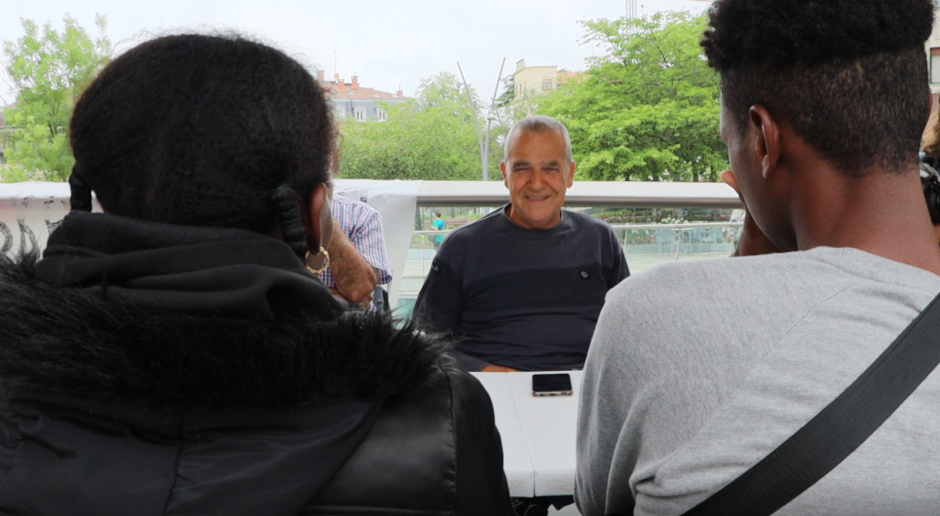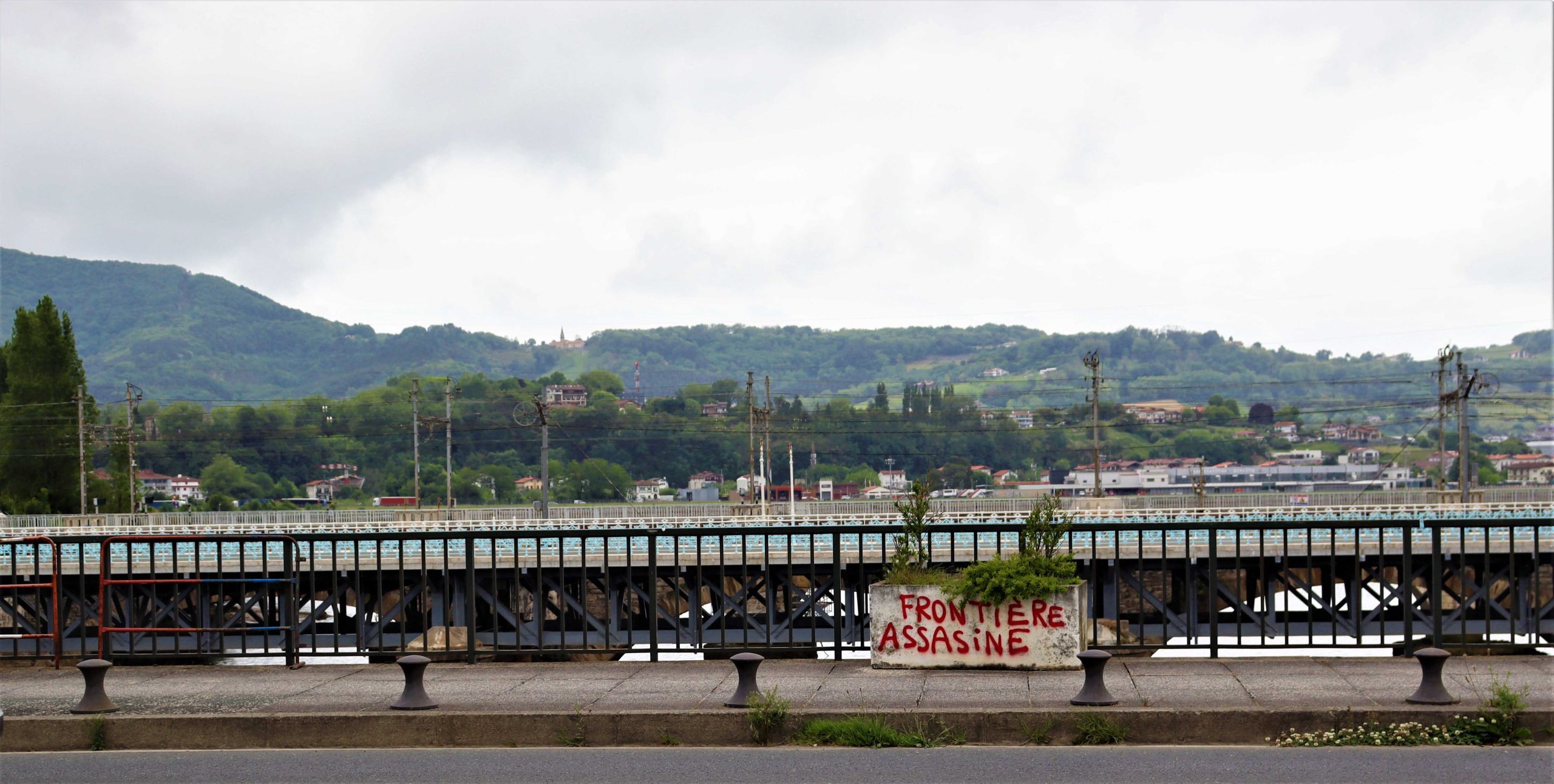Salmon fish swim freely despite the imaginary line dividing the Bidasoa River and defining the border between northern Spain and France. The same does not apply to people who migrate to flee living conditions that threaten their human dignity. The strict French Police control forces irregular migrants to risk their lives through vulnerable river-crossing practices. In the last year and a half, seven Subsaharan African men have lost their lives trying to cross that “flowing” border from Spain to France: four drowned, three fell asleep on the railroad, and one committed suicide. Since then, the public discourse has portrayed the Bidasoa River as a “deadly trap”: dangerous water flow for young “sub-Saharan migrants”.
From a bigger picture, Spain is in the spotlight regarding human rights abuses of migrants and asylum seekers that arrive irregularly in Europe through the Western Mediterranean and the Western Africa-Atlantic route. Only in 2021, more than 40 thousand migrants arrived irregularly in Spain. They face various risks, including shipwrecks on the overseas route to the Spanish mainland or the Canary Islands, as well as violent “pushbacks” when land crossing to the Spanish enclaves of Melilla and Ceuta. The International Organization for Migration found in 2021 that 384 migrants died and disappeared along the Western Mediterranean route, while the number rose to 1.173 on the Atlantic route.
For some of those that arrive in Spain, the journey does not end there. In 2021, more than eight thousand migrants crossed the border from Northern Spain to France. Crossing the Bidasoa River is part of their trajectory to other Northwestern European countries. Most migrants come from former French colonies in Africa. Having social support networks, friends, or relatives, and the language factor seems to influence their decision. Nevertheless, the path is full of difficulties. France is also in the headlines for violating migrants’ rights in informal encampments in Paris and Calais, the northern part of the country.
The French national government has increased border controls based on security reasons, including the terrorist attacks in 2015 and the COVID-19 pandemic. In 2021, around 3.000 migrants per month were sent back from France to Spain for irregularly crossing the border. Despite the adverse circumstances, migrants are determined to try several times to cross the border until successfully overcoming the four-hour time spot the French authorities have to return them to Spain.
Due to the French Police control, migrants are forced to vulnerable “river-crossing” experiences: swimming, following the railroads, and risking their physical integrity to avoid the French authorities. Between 2021 and 2022, four of them drowned in the Bidasoa River: Yaya Karamoko (28 years old) and Sohaibo Billa (38 years old) from Ivory Coast, Abdoulaye Koulibaly from Guinea (18 years old), and Ibrahim Diallo from Senegal (24 years old). Besides, in April 2021, Tessfit from Eritrea (21 years old) committed suicide, and in October the same year, three Argelians died falling asleep on the railroads (28-36 years old).
In November 2021, the mayors of the municipalities of Hondarribia and Irun (Spain), and Hendaya (France) made a joint public statement denouncing the deaths of migrants who drowned in the Bidasoa River. The mayors call for national authorities to give a humanitarian response to avoid the Bidasoa River becoming a “deadly trap for those seeking a better future far from their home countries”. As a direct response, the Spanish local government has placed warning signs to persuade migrants not to cross the border by swimming. Besides, the local authorities in Spain and the Red Cross provide humanitarian assistance for those migrants in transit, offering them food and shelter.
Beyond a fixed natural entity, the Bidasoa River has become a “borderscape”: embodying the contradictions and struggles of society. Local authorities ask for migrants’ prudence: it is an open secret that not everyone can cross the river safely because racial hierarchies build differential mobility experiences, forcing some to a vulnerable river crossing. Blaming the dangerous changeable flows cannot hide the power relationships and hierarchies that define who can safely cross the Santiago International bridge.
Unfortunately, the Bidasoa River is not the only “deadly trap” for migrants heading to France. The Alps border route between Italy and France sheds light on those everyday practices of humanizing nature to exert control over which bodies are “out of place”. Polly Pallister-Wilkins, a scholar from the Political Science Department at the University of Amsterdam, studies how illegalized migrants encounter the Alps border routes, concluding there is a “racialized (re)production of the borderscape”: she calls the Alps as “whitescapes”. While transportation and tourist/resort infrastructures conquer the altitude of the Trans-Alpine borderscape, they also condition and deny mobility of black and brown “bodies-out-of-place,” shaping their journeys and affecting their safety through dangerous hiking trails known by locals as “une petite Méditerranée” or “a small Mediterranean.”
Solidarity blooms in adversity: beyond “deadly traps”
In the Spanish town of Irun, those imaginary lines in the Bidasoa River are contested by local initiatives like “Irungo Harrera Sarea”, who (re)produce alternative ways of perceiving borderscapes. This civil society network has around 100 volunteers that organized themselves in 2018 as a response to groups of migrants in transit stuck in Irun without humanitarian assistance. Accompanying migrants through access to information and clothing are evidence of local counter-narratives.
Every morning the network places a table at Plaza San Juan to carry out informal meetings with migrants in transit. In the picture below, a French-speaking Spanish retiree, one of the leaders of “Irungo Harrera Sarea”, is having a friendly conversation with a group of ten migrants about their rights and asylum-seeking processes. Beyond the public discourse of a “deadly trap”, the Bidasoa River can hopefully be “something else”.

Those built and imagined elements interact in what I call a “flowing borderscape”: where not just water moves but various subjectivities – “ways of perceiving the world” that encounter to shape a territory with textures, memories, fears, and hopes of border crossing. The Bidasoa River is not a politically neutral “deadly trap” but instead a territory resulting from the interaction of various stakeholders and power relationships. Reducing migration to a national security issue implies denying the human dignity of those individuals “river-crossing” the imaginary lines that divide one country from another. As water and salmon fish flow freely, let the banks of the Bidasoa River be “something else” than a “deadly trap”.
This reflective essay is the result of a field trip to Irun (Spain) this Spring 2022 as a student of the “Laboratory on the Criminalization of Solidarity” in the Erasmus Mundus MA on Human Rights, Policy and Practice at the University of Deusto.



